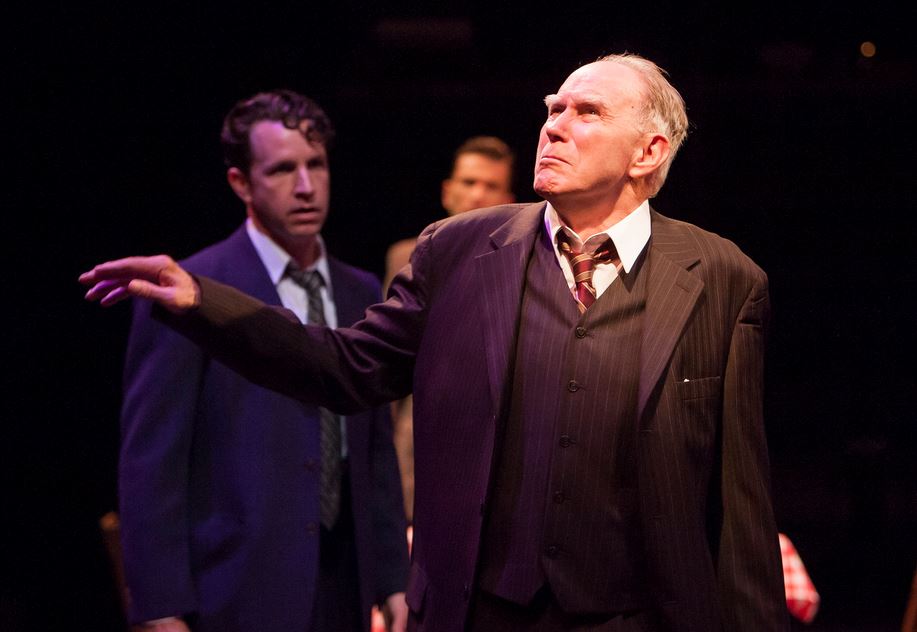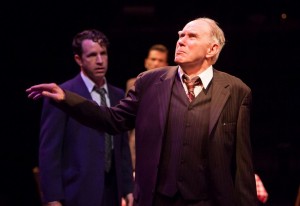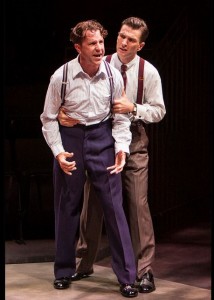
04 Oct Tall Tales: “Death of a Salesman” at Denver Center
Editor’s note: Telluride Inside… and Out’s monthly (more or less) column, Tall Tales, is so named because contributor Mark Stevens is one long drink of water. He is also long on talent. Mark is the author of two Colorado-based mysteries, “Antler Dust” and “Buried by the Roan,” both on the shelves of Telluride’s own Between the Covers Bookstore, 224 West Colorado Ave, Box 2129. (The third book in the series, “Trapline” is due to be released in Fall, 2014). Mark is a former reporter (Denver Post, Christian Science Monitor, Rocky Mountain News) and television producer (MacNeil/Lehrer NewsHour), now working in public relations. He also now writes theatre reviews for TIO, such as the one that follows about Arthur Miller’s Pulitzer- and Tony-winning play about the loss of the American Dream, “Death of a Salesman,” up through October 20. For tickets, go here.
Willy Loman, what haunts you more? Ghosts from the past? Or the fact that you can’t quite chase down that ever-elusive future? You’re so stubborn. You think better days will magically appear on the horizon if you just want them enough, if you insist on their arrival. Like, now.
But here you are, still snarling and struggling. Still sorting out your lies and legacies, your truths and troubles. Trying to get a grip on reality. Trying to steer around the truth. Trying to keep your grip on the road. Trying to ward off the worst kind of obsolescence—the unplanned variety. You’re not ready. You want so badly to cling to now, you’re hanging on by your fingernails. That is, until you don’t.
Willy Loman lives. Death or glory.
At the Denver Center Theater Company’s production of “Death of A Salesman,” running through Oct. 20, Willy Loman spits and sputters, smiles and smirks. The man is desperately torn. He needs to figure out how to get out of the hole he has dug for himself and his family, but he’s too afraid to look back and understand all the lies and hot air that brought him to this place.
The mood on the spare, sharp set is retro. Vintage. Old-timey. There’s the old-fashioned telephone (the kind with a cord) and the tennis racket with the old-fashioned press for the wood frame. But is there any doubt that not a whole heckuva lot has changed in the 64 years since Arthur Miller’s classic was first produced? Is there any doubt we could swap out the props with mobile devices and carbon-fiber racquets and the whole dialogue could vault over the decades and sound just as true today? Is there any doubt that someone, somewhere is just as stuck, just as confused, just as desperate? Lots of someones?
Anthony Powell’s direction of “Death of Salesman” is electric; he wrings riveting performances out of his entire cast. Mike Hartman (as Willy) and Lauren Klein (as his wife, Linda) are married offstage and their relationship on the boards is layered with nuance and depth. How they can power through this intense, dark script more than once a week is beyond me.
Willy’s troublesome sons, who have contributed mightily to the rising sense of doom, are played by John Patrick Hayden (Biff) and M. Scott McLean (Hap) in a pair of brilliant performances. Their behavior and growing recriminations pester and needle poor Willy and when the stakes rise, the exchanges are raw and gritty. Willy’s dead older brother Ben (John Hutton) and his successful neighbor Charley (Michael Santo) both see life in much more black-and-white, matter-of-fact terms and both offer cool counterpoints to Willy’s increasing dread.
“Death of A Salesman” is a classic for a reason. Consumerism. Advertising. False hopes. Self-delusion. Choices. Fatal flaws. Corporate exploitations. Salesmanship. Family. Hope. Dreams. Insurance. On and on.
“Death of A Salesman” can’t boast “a smile and shoeshine” to bring the audience to the door; it’s a downer script if there ever was one. But it’s worth bringing back again and again, as producers from Broadway have done repeatedly (1975, 1984, 1999 and 2012). Don’t miss this crackling run at the Denver Center. The acting is terrific and while the evening requires a solid three hours of watching a man disintegrate, the insights and pathos are worth the agony.
For “Death of A Salesman” to burrow under your skin like a hungry tic, the performances must rise to the level of the challenging script. All I know is that when Mike Hartman’s Willy Loman pointed out the moon rising over the city near the end of act one, I turned to look up, too.
Willy Loman, what haunts you now?
Death or glory. Willy Loman’s tale is not just another story.




Sorry, the comment form is closed at this time.